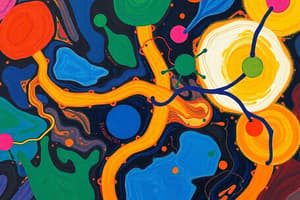Podcast
Questions and Answers
What is the primary storage form of glucose in the human body?
What is the primary storage form of glucose in the human body?
- Glucose
- Glycogen (correct)
- Fructose
- Starch
Which enzyme is considered the rate-limiting enzyme in glycogenesis?
Which enzyme is considered the rate-limiting enzyme in glycogenesis?
- Glycogen phosphorylase
- Hexokinase
- Glucose-6-phosphatase
- Glycogen synthase (correct)
What happens to glucose-6-phosphate in skeletal muscle cells during glycogenolysis?
What happens to glucose-6-phosphate in skeletal muscle cells during glycogenolysis?
- It is released into the bloodstream
- It is stored as glycogen
- It enters the glycolytic pathway (correct)
- It is converted to glucose
What is the main regulatory enzyme for glycogenolysis?
What is the main regulatory enzyme for glycogenolysis?
Which of the following non-carbohydrate sources can be converted into glucose during gluconeogenesis?
Which of the following non-carbohydrate sources can be converted into glucose during gluconeogenesis?
In which organs does gluconeogenesis primarily occur?
In which organs does gluconeogenesis primarily occur?
Which of the following hormones stimulates glycogenolysis in the liver?
Which of the following hormones stimulates glycogenolysis in the liver?
What is the role of lactate in gluconeogenesis?
What is the role of lactate in gluconeogenesis?
Flashcards
Glycogenesis
Glycogenesis
The process of converting glucose into glycogen for storage.
Glycogenolysis
Glycogenolysis
The breakdown of glycogen into glucose for use.
Gluconeogenesis
Gluconeogenesis
The formation of glucose from non-carbohydrate sources.
Glycogen
Glycogen
Signup and view all the flashcards
Glycogen breakdown in liver
Glycogen breakdown in liver
Signup and view all the flashcards
Glycogen breakdown in muscle
Glycogen breakdown in muscle
Signup and view all the flashcards
Gluconeogenesis sources
Gluconeogenesis sources
Signup and view all the flashcards
Glycogenolysis regulation
Glycogenolysis regulation
Signup and view all the flashcards
Study Notes
Glycogen Metabolism and Gluconeogenesis
- Goal: Understand glycogen metabolism and gluconeogenesis.
- Objectives:
- Explain glycogenesis and glycogenolysis.
- Explain gluconeogenesis.
- Explain the regulation of these processes.
- Apply knowledge to real-world or clinical scenarios.
- Keywords: glycogenesis, glycogenolysis, gluconeogenesis.
- Reading: Essential Cell Biology, Alberts, Chapters 13 and 14, or any biochemistry textbook.
I. Glycogenesis
- Glycogen: Storage form of glucose.
- Structure: Polysaccharide.
- Storage: Stored in liver and muscle; storage is limited. Once stores are full, no more glucose can be stored as glycogen.
- Process: Glucose → glucose-6-phosphate (by hexokinase/glucokinase) → glucose-1-phosphate → uridine diphosphate glucose → glycogen.
- Rate-limiting enzyme: Glycogen synthase.
II. Glycogenolysis
- Process: Glycogen → glucose-1-phosphate (by glycogen phosphorylase) → glucose-6-phosphate.
- Liver: Glucose-6-phosphate → glucose (by glucose-6-phosphatase). Released into the blood for other tissues (especially brain).
- Muscle: No glucose-6-phosphatase. Glucose-6-phosphate enters the glycolytic pathway.
III. Gluconeogenesis
- Definition: Formation of glucose from non-carbohydrate sources.
- Sources: Certain amino acids, lactate, glycerol, and Krebs cycle intermediates (e.g., oxaloacetate).
- Location: Primarily in the liver and kidneys
- Mechanism: Lactate and certain amino acids are converted to pyruvate, which is then converted to glucose via reverse glycolysis. Glycerol is converted to glyceraldehydes-3-phosphate, then glucose via reverse glycolysis.
IV. Regulation of Carbohydrate Metabolism
-
Glycogenolysis Regulation:
- Rate-limiting enzyme: Glycogen phosphorylase.
- Stimulated by: AMP, glucagon (liver only), epinephrine.
- Inhibited by: ATP, insulin.
-
Glycogenesis Regulation:
- Rate-limiting enzyme: Glycogen synthase.
- Stimulated by: Insulin.
- Inhibited by: Glucagon, epinephrine.
-
Gluconeogenesis Regulation:
- Stimulated by: Glucagon.
- Inhibited by: Insulin.
-
Brain Glucose Uptake: Insulin is not required for the brain to take up glucose. Glucagon does not inhibit glycolysis in the brain. High glucagon, low insulin (e.g., starvation), allows the brain to use glucose from gluconeogenesis and glycogenolysis.
Studying That Suits You
Use AI to generate personalized quizzes and flashcards to suit your learning preferences.



